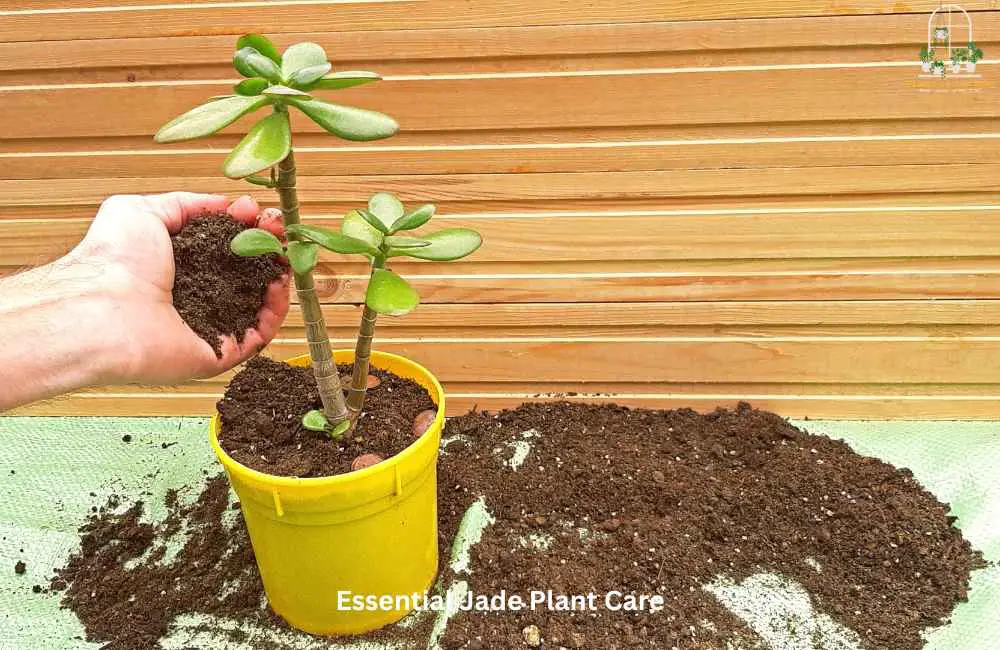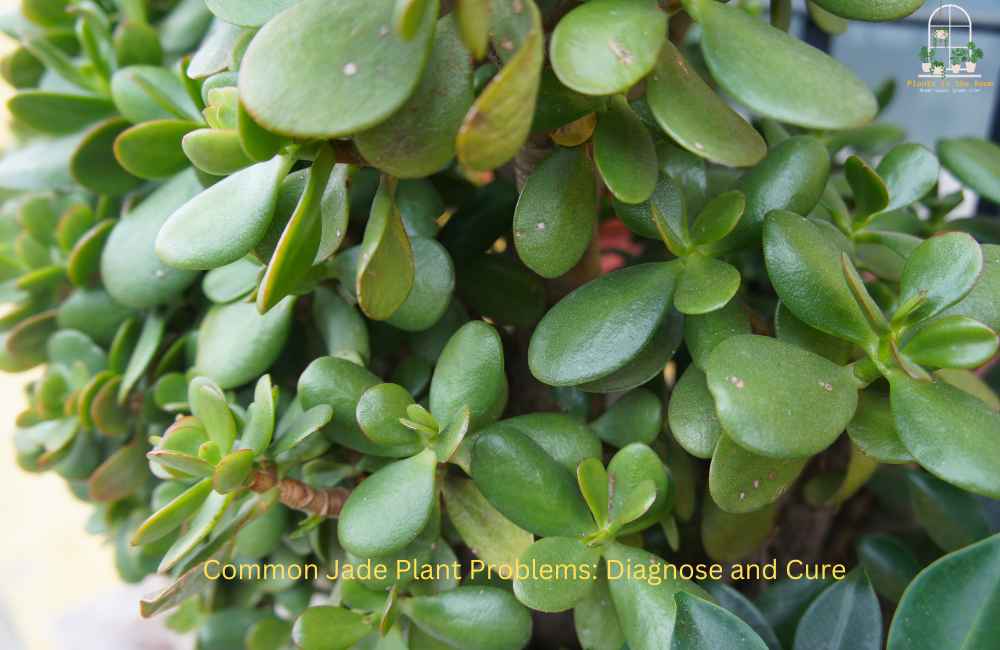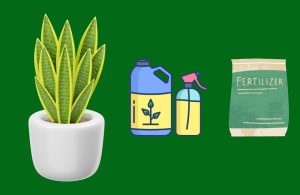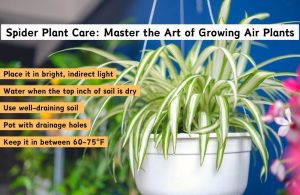This article covers the following areas –
- The Basics of Jade Plant
- Essential Jade Plant Care
- Common Jade Plant Problems: Diagnose and Cure
- Final Words
The Jade plant, scientifically known as Crassula ovata, is a beautiful and versatile succulent often called the ‘money plant.’ Its popularity primarily stems from the belief in its ability to bring prosperity and good luck, a concept originating from Feng Shui traditions. This glossy, green-leafed plant is low maintenance, making it perfect for both experienced gardeners and beginners. In this article, I’ll delve into the necessary details to help you nurture your Jade plant for optimal growth and good luck.
Jade plant requires 4-6 hours of sunlight daily and is kept at temperatures between 65°F-75°F. Watering should follow the ‘soak and dry’ technique, and feeding should occur once every three months during the growing season.
For more details on each aspect of Jade plant care, continue reading this comprehensive guide. We delve into how to prevent common problems like yellowing or dropping leaves and leggy growth, ensuring your Jade plant thrives and brings prosperity into your home.

The Basics of Jade Plant
Jade plants are native to the semi-arid regions of South Africa. They are regarded as symbols of good luck and prosperity in Chinese culture and globally. The Jade plant’s vibrant green leaves, which can resemble coins, reinforce its association with wealth and abundance.
A mature Jade plant can grow up to 2 meters tall if cultivated under the right conditions. It has thick, woody stems and shiny, dark green leaves that may develop a reddish tinge on the edges when exposed to plenty of sunlight. Additionally, it can produce small white or pink star-shaped flowers during the cooler months.
Essential Jade Plant Care

The captivating allure of the Jade plant lies not just in its supposed ability to bring wealth and good luck but also in its easy maintenance. However, as with any other plant, the key to nurturing a healthy Jade plant is understanding its specific needs and providing it with the right environment to flourish.
Lighting and Temperature
One of the keys to keeping your Jade plant healthy and happy is to provide it with the right lighting and temperature conditions. As sun-loving succulents, Jade plants have specific light exposure and ambient temperature needs. Too much or too little of either can cause damage and hinder growth. So, let’s delve deeper into understanding these requirements.
Lighting
Jade plants thrive best when exposed to bright, indirect sunlight. Originating from semi-arid regions, these plants are designed to absorb and store sunlight effectively. To recreate these conditions at home, ensure your Jade plant receives around four to six hours of sunlight daily.
Placing your Jade plant near a south or west-facing window often provides the ideal amount of sunlight. These directions typically receive the most light throughout the day, ensuring your plant gets ample sunshine.
However, even though Jade plants love sunlight, they can still get sunburned. Sunburn on Jade plants appears as brown, scorched spots on the leaves and can lead to leaf drop if left unchecked.
Here are some tips to prevent sunburn:
- Gradually acclimate your plant to sunlight: Don’t immediately move it to direct sunlight if used in low light conditions. Instead, increase the light exposure gradually over a few weeks.
- Use a sheer curtain: If your Jade plant is exposed to intense direct sunlight, consider diffusing the light with a sheer curtain. This can reduce the intensity of the sun’s rays without significantly decreasing the light your plant receives.
- Rotate your plant: Rotate your Jade plant every few weeks to ensure all sides get even light exposure. This prevents one side from getting more sunburned than the others and encourages balanced growth.
Temperature
The ideal temperature range for Jade plants lies between 65°F (18°C) and 75°F (24°C). These temperatures mimic the Jade plant’s natural environment and can promote optimal growth. Jade plants can tolerate slight temperature fluctuations but are sensitive to extreme cold.
Protecting your Jade plant from cold drafts and low temperatures is important during the winter months. A sudden drop in temperature can shock the plant and cause chilling injuries. Signs of cold damage include blackened leaves and soft, mushy stems.
Here are some tips to maintain the right temperature:
- Move your plant away from drafty windows in winter: Cold drafts can significantly lower the surrounding temperature. If your Jade plant is near a window, consider moving it to a warmer spot during winter.
- Avoid placing your Jade plant near heat vents: While Jade plants like warmth, hot, dry air from heat vents can cause the plant to dehydrate and drop leaves.
- Use a thermometer: If you’re unsure about the temperature, use an indoor thermometer to keep track. This can help you ensure the temperature stays within the optimal range.
Remember, maintaining the right lighting and temperature conditions is crucial for your Jade plant’s well-being. Regularly check your plant and its surroundings, adjusting its care as necessary. With proper attention, your Jade plant can thrive and continue to be a source of good luck and prosperity in your home.
Watering and Feeding
The basic elements of sustenance for any plant are water and nutrients, and the Jade plant is no exception. While these resilient plants have adapted to survive in harsh conditions, they still need a proper balance of watering and feeding to thrive. Understanding the Jade plant’s watering and feeding requirements can transform it from surviving to growing vigorously.
Watering
A hallmark of Jade plants is their remarkable ability to endure drought-like conditions. But this doesn’t mean they can go completely without water. One effective watering method that closely replicates the natural conditions of the Jade plant is the ‘soak and dry’ technique.
You water your plant generously in this method, soaking the soil completely. Once the water drains out, do not water it again until the soil dries. This approach allows the roots to absorb enough water while the dry phase prevents them from staying waterlogged, which could lead to root rot.
Overwatering is, indeed, one of the biggest threats to Jade plants. When the roots are continually exposed to water, they can develop root rot, a serious condition characterized by brown, mushy roots and wilted leaves. To prevent this, always ensure your plant pot has adequate drainage holes, allowing excess water to escape.
Here are some watering tips:
- Watering frequency can vary based on the season. When the plant is actively growing in summer, you might need to water every 1-2 weeks. When growth slows down in winter, watering once a month may be sufficient.
- If you’re unsure about when to water next, check the soil. If the top 1-2 inches are dry, it’s a good sign that you need to water.
- Always water at the base of the plant, avoiding the leaves. Wet leaves can invite fungal diseases.
Feeding
Jade plants, like all living beings, require nutrients for growth. Providing these nutrients as a succulent fertilizer can ensure your plant grows robustly. The best time to feed your Jade plant is during its growing season, typically spring and summer.
Use a diluted succulent fertilizer and feed your plant once every three months. Feeding too frequently can lead to excessive and weak growth, so it’s better to err on the side of underfeeding.
During winter, the Jade plant enters a dormant phase and grows less actively. It’s best to stop feeding during this period as the plant isn’t using as many nutrients. If you continue to feed, it could lead to “leggy” or stretched growth as the plant tries to use up the extra nutrients.
Here are some feeding tips:
- Always follow the manufacturer’s instructions on the fertilizer package. Too much fertilizer can “burn” the roots and harm the plant.
- If you notice your Jade plant’s leaves turning yellow or growth seems stunted despite proper watering, it might be a sign of nutrient deficiency, indicating it’s time to feed your plant.
- After feeding, water your plant thoroughly. This helps distribute the nutrients evenly throughout the soil.
The right watering and feeding practices can greatly contribute to the health and growth of your Jade plant. Remember, each plant is unique, so observing your Jade plant’s responses to watering and feeding and adjusting your care practices as needed is important. This way, your Jade plant will survive and thrive, bringing you its famed good luck and prosperity.
Soil and Repotting
The type of soil in which a Jade plant grows significantly impacts its health and growth, while repotting can invigorate its growth and longevity. Let’s look closer at the ideal soil for a Jade plant and when and how to repot it.
Soil
Jade plants, being succulents, require soil that provides excellent drainage. These plants are highly susceptible to root rot, which is commonly caused by overly wet soil. Therefore, the first characteristic to look for in your soil mix is its ability to drain water quickly.
A commercially available cactus mix is often a great choice, specifically designed to promote good drainage. These mixes usually blend organic material, sand, or perlite, providing the loose and well-aerated environment that Jade plants love.
If you prefer a DIY approach, you can easily create an ideal soil mix for your Jade plant at home. Combine one part sterile potting soil, one part coarse sand, and one part perlite or pumice. This blend offers excellent drainage while retaining just the right amount of moisture for the plant’s needs.
Repotting
Repotting is crucial to Jade plant care, ensuring its continued growth and vigor. However, the frequency of repotting depends on the age of your Jade plant.
Young Jade plants tend to grow relatively quickly and may outgrow their containers within 2-3 years. At this stage, regular repotting helps accommodate their growing root system and prevents them from becoming root-bound.
As your Jade plant matures, its growth rate slows down. You will likely need to repot it only every 4-5 years. The primary sign that it’s time to repot is when the pot starts to crack or break under the weight of the plant or when the plant begins to topple over because it’s top-heavy.
When repotting your Jade plant, always choose a new pot with enough drainage holes to prevent waterlogging. It’s recommended to wait for about a week before watering after repotting. This gives the plant time to adjust to its new environment and allows any damaged roots to heal.
Taking care of a Jade plant might seem like a lot of work initially. However, understanding its needs and rhythms becomes a rewarding and therapeutic activity. Remember, the goal is to mimic the plant’s natural environment as much as possible. By following these detailed care instructions, you’re well on your way to nurturing a vibrant and healthy Jade plant. This good luck and prosperity symbol can beautify your living space and bring you a sense of achievement and peace.
Common Jade Plant Problems: Diagnose and Cure

Nurturing a Jade plant can be a rewarding experience, with its lush green leaves and intricate branching being a sight to behold. However, like all living things, Jade plants can occasionally encounter health issues. Promptly identifying the signs of distress and addressing the underlying causes can save your plant from irreversible damage.
#1 Yellowing Leaves
Yellowing leaves are a telltale sign that your Jade plant may be distressed. Overwatering is a common cause of this issue. If your Jade plant’s leaves are transitioning from vibrant green to a dull yellow, it’s time to evaluate your watering practices.
Overwatering can lead to waterlogged soil, creating an environment conducive to root rot—a detrimental condition that can cause serious harm to your Jade plant. The solution lies in adjusting your watering schedule. Jade plants prefer a ‘soak and dry’ watering method where the soil can dry out completely between watering sessions. This approach mimics their natural habitat conditions, allowing them to thrive.
It’s also important to evaluate your plant’s pot. Proper drainage is essential for preventing overwatering. If your pot lacks adequate drainage holes, it might be time for an upgrade. Look for a pot that effectively drains excess water, keeping your Jade plant’s soil environment balanced and healthy.
#2 Dropping Leaves
Just as overwatering can lead to problems, so can underwatering. Jade plants are robust and drought-resistant but still need moisture to survive. If the leaves of your Jade plant are dropping and the soil is bone-dry, your plant might be crying out for water.
Underwatered Jade plants often have wilted or shriveled leaves. To resolve this, you might need to increase your watering frequency. However, remember not to overcompensate by watering too much. Use the ‘soak and dry’ method mentioned above, allowing the soil to dry out entirely before the next watering. This approach prevents overwatering and underwatering, maintaining the optimal moisture level for your Jade plant.
#3 Leggy Growth
Sunlight plays a crucial role in the health and appearance of your Jade plant. Insufficient light can lead to leggy growth, where the plant stretches towards the light source, resulting in elongated stems and fewer leaves.
If your Jade plant grows leggy, it may not get enough sunlight. Consider moving your Jade plant to a brighter location, ideally near a south or west-facing window. If moving the plant is not an option, you could supplement natural light with a grow light. This can help ensure your plant receives the light it needs to grow compact and bushy rather than leggy and sparse.
Navigating the world of Jade plant care might seem overwhelming initially, but with a keen eye and some know-how, you can quickly diagnose and address any issues that arise. By understanding these common Jade plant problems, you are well-equipped to keep it healthy, allowing it to continue being a source of beauty and good luck in your home.
Final Words
While Jade plant care may seem complex, understanding its basic needs can simplify the process. Ensuring adequate sunlight, controlling the temperature, perfecting your watering and feeding schedule, and providing well-draining soil is key to nurturing a healthy Jade plant.
Armed with this knowledge, you can address any issue that arises, enhancing your Jade plant’s longevity and vitality. Remember, this resilient plant doesn’t just serve as an eye-catching addition to your indoor plant collection, but it’s also believed to attract good luck and prosperity. So, give it the care it deserves, and it will return the favor manifold.






